histogram
Histogram plot
Description
Histograms are a type of bar plot for numeric data that group the data into bins. After you create aHistogramobject, you can modify aspects of the histogram by changing its property values. This is particularly useful for quickly modifying the properties of the bins or changing the display.
Creation
Syntax
Description
histogram(creates a histogram plot ofX)X. Thehistogramfunction uses an automatic binning algorithm that returns bins with a uniform width, chosen to cover the range of elements inXand reveal the underlying shape of the distribution.histogramdisplays the bins as rectangles such that the height of each rectangle indicates the number of elements in the bin.
histogram(, whereC)Cis a categorical array, plots a histogram with a bar for each category inC.
histogram(plots only the subset of categories specified byC,Categories)Categories.
histogram('Categories',manually specifies categories and associated bin counts.Categories,'BinCounts',counts)histogramplots the specified bin counts and does not do any data binning.
histogram(___,specifies additional options with one or moreName,Value)Name,Valuepair arguments using any of the previous syntaxes. For example, you can specify'BinWidth'and a scalar to adjust the width of the bins, or'Normalization'with a valid option ('count','probability','countdensity','pdf','cumcount', or'cdf')使用不同类型的正常化。对于一个list of properties, seeHistogram Properties.
histogram(plots into the axes specified byax,___)axinstead of into the current axes (gca). The optionaxcan precede any of the input argument combinations in the previous syntaxes.
h= histogram(___)Histogramobject. Use this to inspect and adjust the properties of the histogram. For a list of properties, seeHistogram Properties.
Input Arguments
X—数据分发垃圾箱中
vector|matrix|multidimensional array
数据分发垃圾箱中, specified as a vector, matrix, or multidimensional array. IfXis not a vector, thenhistogramtreats it as a single column vector,X(:), and plots a single histogram.
histogramignores allNaNandNaTvalues. Similarly,histogramignoresInfand-Infvalues, unless the bin edges explicitly specifyInfor-Infas a bin edge. AlthoughNaN,NaT,Inf, and-Infvalues are typically not plotted, they are still included in normalization calculations that include the total number of data elements, such as'probability'.
Note
IfXcontains integers of typeint64oruint64that are larger thanflintmax, then it is recommended that you explicitly specify the histogram bin edges.histogramautomatically bins the input data using double precision, which lacks integer precision for numbers greater thanflintmax.
Data Types:single|double|int8|int16|int32|int64|uint8|uint16|uint32|uint64|logical|datetime|duration
C—Categorical data
categorical array
Categorical data, specified as a categorical array.histogramdoes not plot undefined categorical values. However, undefined categorical values are still included in normalization calculations that include the total number of data elements, such as'probability'.
Data Types:categorical
nbins—Number of bins
positive integer
Number of bins, specified as a positive integer. If you do not specifynbins, thenhistogramautomatically calculates how many bins to use based on the values inX.
Example:histogram(X,15)creates a histogram with 15 bins.
edges—Bin edges
vector
Bin edges, specified as a vector.edges(1)is the left edge of the first bin, andedges(end)is the right edge of the last bin.
The valueX(i)is in thekth bin ifedges(k)≤X(i)<edges(k+1). The last bin also includes the right bin edge, so that it containsX(i)ifedges(end-1)≤X(i)≤edges(end).
For datetime and duration data,edges必须是一个datetime或持续时间向量在单调吗ally increasing order.
Data Types:single|double|int8|int16|int32|int64|uint8|uint16|uint32|uint64|logical|datetime|duration
Categories—Categories included in histogram
cell array of character vectors|categorical array|string array
Note
This option only applies to categorical histograms.
Categories included in histogram, specified as a cell array of character vectors, categorical array, or string array.
If you specify an input categorical array
C, then by default,histogramplots a bar for each category inC. In that case, useCategoriesto specify a unique subset of the categories instead.If you specify bin counts, then
Categoriesspecifies the associated category names for the histogram.
Example:h = histogram(C,{'Large','Small'})plots only the categorical data in the categories'Large'and'Small'.
Example:histogram('Categories',{'Yes','No','Maybe'},'BinCounts',[22 18 3])plots a histogram that has three categories with the associated bin counts.
Example:h.Categoriesqueries the categories that are in histogram objecth.
Data Types:cell|categorical|string
counts—Bin counts
vector
Bin counts, specified as a vector. Use this input to pass bin counts tohistogramwhen the bin counts calculation is performed separately and you do not wanthistogramto do any data binning.
The length ofcountsmust be equal to the number of bins.
For numeric histograms, the number of bins is
length(edges)-1.For categorical histograms, the number of bins is equal to the number of categories.
Example:histogram('BinEdges',-2:2,'BinCounts',[5 8 15 9])
Example:histogram('Categories',{'Yes','No','Maybe'},'BinCounts',[22 18 3])
ax—Target axes
Axesobject|PolarAxesobject
Target axes, specified as anAxesobject or aPolarAxesobject. If you do not specify the axes and if the current axes are Cartesian axes, then thehistogramfunction uses the current axes (gca). To plot into polar axes, specify thePolarAxesobject as the first input argument or use thepolarhistogramfunction.
Specify optional pairs of arguments asName1=Value1,...,NameN=ValueN, whereNameis the argument name andValueis the corresponding value. Name-value arguments must appear after other arguments, but the order of the pairs does not matter.
Before R2021a, use commas to separate each name and value, and encloseNamein quotes.
Example:histogram(X,'BinWidth',5)
The histogram properties listed here are only a subset. For a complete list, seeHistogram Properties.
BarWidth—Relative width of categorical bars
0.9(default) |scalar in range[0,1]
Note
This option only applies to histograms of categorical data.
Relative width of categorical bars, specified as a scalar value in the range[0,1]. Use this property to control the separation of categorical bars within the histogram. The default value is0.9, which means that the bar width is 90% of the space from the previous bar to the next bar, with 5% of that space on each side.
If you set this property to1, then adjacent bars touch.
Example:0.5
Data Types:single|double|int8|int16|int32|int64|uint8|uint16|uint32|uint64
BinLimits—Bin limits
two-element vector
Bin limits, specified as a two-element vector,[bmin,bmax]. This option plots a histogram using the values in the input array,X,介于bminandbmaxinclusive. That is,X(X>=bmin & X<=bmax).
This option does not apply to histograms of categorical data.
Example:histogram(X,'BinLimits',[1,10])plots a histogram using only the values inXthat are between1and10inclusive.
BinLimitsMode—Selection mode for bin limits
'auto'(default) |'manual'
Selection mode for bin limits, specified as'auto'or'manual'. The default value is'auto', so that the bin limits automatically adjust to the data.
If you explicitly specify eitherBinLimitsorBinEdges, thenBinLimitsModeis automatically set to'manual'. In that case, specifyBinLimitsModeas'auto'to rescale the bin limits to the data.
This option does not apply to histograms of categorical data.
BinMethod—Binning algorithm
'auto'(default) |'scott'|'fd'|'integers'|'sturges'|'sqrt'| ...
Binning algorithm, specified as one of the values in this table.
Value |
Description |
|---|---|
|
The default |
|
Scott’s rule is optimal if the data is close to being normally distributed. This rule is appropriate for most other distributions, as well. It uses a bin width of |
|
The Freedman-Diaconis rule is less sensitive to outliers in the data, and might be more suitable for data with heavy-tailed distributions. It uses a bin width of |
|
The integer rule is useful with integer data, as it creates a bin for each integer. It uses a bin width of 1 and places bin edges halfway between integers. To avoid accidentally creating too many bins, you can use this rule to create a limit of 65536 bins (216). If the data range is greater than 65536, then the integer rule uses wider bins instead. Note
|
|
Sturges’ rule is popular due to its simplicity. It chooses the number of bins to be |
|
The Square Root rule is widely used in other software packages. It chooses the number of bins to be |
histogram并不总是选择使用th垃圾箱的数量ese exact formulas. Sometimes the number of bins is adjusted slightly so that the bin edges fall on "nice" numbers.
For datetime data, the bin method can be one of these units of time:
'second' |
'month' |
'minute' |
'quarter' |
'hour' |
'year' |
'day' |
'decade' |
'week' |
'century' |
For duration data, the bin method can be one of these units of time:
'second' |
'day' |
'minute' |
'year' |
'hour' |
If you specifyBinMethodwith datetime or duration data, thenhistogramcan use a maximum of 65,536 bins (or 216). If the specified bin duration requires more bins, thenhistogramuses a larger bin width corresponding to the maximum number of bins.
This option does not apply to histograms of categorical data.
Note
If you set theBinLimits,NumBins,BinEdges, orBinWidthproperty, then theBinMethodproperty is set to'manual'.
Example:histogram(X,'BinMethod','integers')creates a histogram with the bins centered on integers.
BinWidth—Width of bins
scalar
Width of bins, specified as a scalar. When you specifyBinWidth, thenhistogramcan use a maximum of 65,536 bins (or216). If instead the specified bin width requires more bins, thenhistogramuses a larger bin width corresponding to the maximum number of bins.
For datetime and duration data, the value of'BinWidth'can be a scalar duration or calendar duration.
This option does not apply to histograms of categorical data.
Example:histogram(X,'BinWidth',5)uses bins with a width of 5.
DisplayOrder—Category display order
'data'(default) |'ascend'|'descend'
Category display order, specified as'ascend','descend', or'data'. With'ascend'or'descend', the histogram displays with increasing or decreasing bar heights. The default'data'value uses the category order in the input data,C.
This option only works with categorical data.
DisplayStyle—Histogram display style
'bar'(default) |'stairs'
Histogram display style, specified as either'bar'or'stairs'. Specify'stairs'to display a stairstep plot, which displays the outline of the histogram without filling the interior.
The default value of'bar'displays a histogram bar plot.
Example:histogram(X,'DisplayStyle','stairs')plots the outline of the histogram.
EdgeAlpha—Transparency of histogram bar edges
1(default) |scalar value between0and1inclusive
Transparency of histogram bar edges, specified as a scalar value between0and1inclusive. A value of1means fully opaque and0means completely transparent (invisible).
Example:histogram(X,'EdgeAlpha',0.5)creates a histogram plot with semi-transparent bar edges.
EdgeColor—Histogram edge color
[0 0 0]或黑色(default) |'none'|'auto'|RGB triplet|hexadecimal color code|color name
Histogram edge color, specified as one of these values:
'none'— Edges are not drawn.'auto'— Color of each edge is chosen automatically.RGB triplet, hexadecimal color code, or color name — Edges use the specified color.
RGB triplets and hexadecimal color codes are useful for specifying custom colors.
An RGB triplet is a three-element row vector whose elements specify the intensities of the red, green, and blue components of the color. The intensities must be in the range
[0,1]; for example,[0.4 0.6 0.7].A hexadecimal color code is a character vector or a string scalar that starts with a hash symbol (
#) followed by three or six hexadecimal digits, which can range from0toF. The values are not case sensitive. Thus, the color codes'#FF8800','#ff8800','#F80', and'#f80'are equivalent.
Alternatively, you can specify some common colors by name. This table lists the named color options, the equivalent RGB triplets, and hexadecimal color codes.
Color Name Short Name RGB Triplet Hexadecimal Color Code Appearance 'red''r'[1 0 0]'#FF0000'
'green''g'[0 1 0]'#00FF00'
'blue''b'[0 0 1]'#0000FF'
'cyan''c'[0 1 1]'#00FFFF'
'magenta''m'[1 0 1]'#FF00FF'
'yellow''y'[1 1 0]'#FFFF00'
'black''k'[0 0 0]'#000000'
'white''w'[1 1 1]'#FFFFFF'
Here are the RGB triplets and hexadecimal color codes for the default colors MATLAB®uses in many types of plots.
RGB Triplet Hexadecimal Color Code Appearance [0 0.4470 0.7410]'#0072BD'![Sample of RGB triplet [0 0.4470 0.7410], which appears as dark blue](//www.tianjin-qmedu.com/help/techdoc/ref/colororder1.png)
[0.8500 0.3250 0.0980]'#D95319'![Sample of RGB triplet [0.8500 0.3250 0.0980], which appears as dark orange](//www.tianjin-qmedu.com/help/techdoc/ref/colororder2.png)
[0.9290 0.6940 0.1250]'#EDB120'![Sample of RGB triplet [0.9290 0.6940 0.1250], which appears as dark yellow](//www.tianjin-qmedu.com/help/techdoc/ref/colororder3.png)
[0.4940 0.1840 0.5560]'#7E2F8E'![Sample of RGB triplet [0.4940 0.1840 0.5560], which appears as dark purple](//www.tianjin-qmedu.com/help/techdoc/ref/colororder4.png)
[0.4660 0.6740 0.1880]'#77AC30'![Sample of RGB triplet [0.4660 0.6740 0.1880], which appears as medium green](//www.tianjin-qmedu.com/help/techdoc/ref/colororder5.png)
[0.3010 0.7450 0.9330]'#4DBEEE'![Sample of RGB triplet [0.3010 0.7450 0.9330], which appears as light blue](//www.tianjin-qmedu.com/help/techdoc/ref/colororder6.png)
[0.6350 0.0780 0.1840]'#A2142F'![Sample of RGB triplet [0.6350 0.0780 0.1840], which appears as dark red](//www.tianjin-qmedu.com/help/techdoc/ref/colororder7.png)
Example:histogram(X,'EdgeColor','r')creates a histogram plot with red bar edges.
FaceAlpha—Transparency of histogram bars
0.6(default) |scalar value between0and1inclusive
Transparency of histogram bars, specified as a scalar value between0and1inclusive.histogramuses the same transparency for all the bars of the histogram. A value of1means fully opaque and0means completely transparent (invisible).
Example:histogram(X,'FaceAlpha',1)creates a histogram plot with fully opaque bars.
FaceColor—Histogram bar color
'auto'(default) |'none'|RGB triplet|hexadecimal color code|color name
Histogram bar color, specified as one of these values:
'none'— Bars are not filled.'auto'— Histogram bar color is chosen automatically (default).RGB triplet, hexadecimal color code, or color name — Bars are filled with the specified color.
RGB triplets and hexadecimal color codes are useful for specifying custom colors.
An RGB triplet is a three-element row vector whose elements specify the intensities of the red, green, and blue components of the color. The intensities must be in the range
[0,1]; for example,[0.4 0.6 0.7].A hexadecimal color code is a character vector or a string scalar that starts with a hash symbol (
#) followed by three or six hexadecimal digits, which can range from0toF. The values are not case sensitive. Thus, the color codes'#FF8800','#ff8800','#F80', and'#f80'are equivalent.
Alternatively, you can specify some common colors by name. This table lists the named color options, the equivalent RGB triplets, and hexadecimal color codes.
Color Name Short Name RGB Triplet Hexadecimal Color Code Appearance 'red''r'[1 0 0]'#FF0000'
'green''g'[0 1 0]'#00FF00'
'blue''b'[0 0 1]'#0000FF'
'cyan''c'[0 1 1]'#00FFFF'
'magenta''m'[1 0 1]'#FF00FF'
'yellow''y'[1 1 0]'#FFFF00'
'black''k'[0 0 0]'#000000'
'white''w'[1 1 1]'#FFFFFF'
Here are the RGB triplets and hexadecimal color codes for the default colors MATLAB uses in many types of plots.
RGB Triplet Hexadecimal Color Code Appearance [0 0.4470 0.7410]'#0072BD'![Sample of RGB triplet [0 0.4470 0.7410], which appears as dark blue](//www.tianjin-qmedu.com/help/techdoc/ref/colororder1.png)
[0.8500 0.3250 0.0980]'#D95319'![Sample of RGB triplet [0.8500 0.3250 0.0980], which appears as dark orange](//www.tianjin-qmedu.com/help/techdoc/ref/colororder2.png)
[0.9290 0.6940 0.1250]'#EDB120'![Sample of RGB triplet [0.9290 0.6940 0.1250], which appears as dark yellow](//www.tianjin-qmedu.com/help/techdoc/ref/colororder3.png)
[0.4940 0.1840 0.5560]'#7E2F8E'![Sample of RGB triplet [0.4940 0.1840 0.5560], which appears as dark purple](//www.tianjin-qmedu.com/help/techdoc/ref/colororder4.png)
[0.4660 0.6740 0.1880]'#77AC30'![Sample of RGB triplet [0.4660 0.6740 0.1880], which appears as medium green](//www.tianjin-qmedu.com/help/techdoc/ref/colororder5.png)
[0.3010 0.7450 0.9330]'#4DBEEE'![Sample of RGB triplet [0.3010 0.7450 0.9330], which appears as light blue](//www.tianjin-qmedu.com/help/techdoc/ref/colororder6.png)
[0.6350 0.0780 0.1840]'#A2142F'![Sample of RGB triplet [0.6350 0.0780 0.1840], which appears as dark red](//www.tianjin-qmedu.com/help/techdoc/ref/colororder7.png)
If you specifyDisplayStyleas'stairs', thenhistogramdoes not use theFaceColorproperty.
Example:histogram(X,'FaceColor','g')creates a histogram plot with green bars.
LineStyle—Line style
“- - -”(default) |'--'|':'|'-.'|'none'
Line style, specified as one of the options listed in this table.
| Line Style | Description | Resulting Line |
|---|---|---|
“- - -” |
Solid line |
|
'--' |
Dashed line |
|
':' |
Dotted line |
|
'-.' |
Dash-dotted line |
|
'none' |
No line | No line |
LineWidth—Width of bar outlines
0.5(default) |positive value
宽度的酒吧了,指定为一个积极的瓦尔ue in point units. One point equals 1/72 inch.
Example:1.5
Data Types:single|double|int8|int16|int32|int64|uint8|uint16|uint32|uint64
Normalization—Type of normalization
'count'(default) |'probability'|'countdensity'|'pdf'|'cumcount'|'cdf'
Type of normalization, specified as one of the values in this table. For each bini:
is the bin value.
is the number of elements in the bin.
is the width of the bin.
is the number of elements in the input data. This value can be greater than the binned data if the data contains
NaN,NaT, or
| Value | Bin Values | Notes |
|---|---|---|
'count'(default) |
|
|
'countdensity' |
|
Note
|
'cumcount' |
|
|
'probability' |
|
|
'pdf' |
|
Note
|
'cdf' |
|
|
Example:histogram(X,'Normalization','pdf')plots an estimate of the probability density function forX.
NumDisplayBins—Number of categories to display
scalar
Number of categories to display, specified as a scalar. You can change the ordering of categories displayed in the histogram using the'DisplayOrder'option.
This option only works with categorical data.
Orientation—Orientation of bars
'vertical'(default) |'horizontal'
Orientation of bars, specified as'vertical'or'horizontal'.
Example:histogram(X,'Orientation','horizontal')creates a histogram plot with horizontal bars.
ShowOthers—Toggle summary display of data belonging to undisplayed categories
'off'(default) |on/off logical value
Toggle summary display of data belonging to undisplayed categories, specified as'on'or'off', or as numeric or logical1(true) or0(false). A value of'on'相当于true, and'off'相当于false. Thus, you can use the value of this property as a logical value. The value is stored as an on/off logical value of typematlab.lang.OnOffSwitchState.
Set this option to'on'to display an additional bar in the histogram with the name'Others'. This extra bar counts all elements that do not belong to categories displayed in the histogram.
You can change the number of categories displayed in the histogram, as well as their order, using the'NumDisplayBins'and'DisplayOrder'options.
This option only works with categorical data.
Output Arguments
h— Histogram
object
Histogram, returned as an object. For more information, seeHistogram Properties.
Properties
| Histogram Properties | Histogram appearance and behavior |
Object Functions
Examples
Histogram of Vector
Generate 10,000 random numbers and create a histogram. Thehistogramfunction automatically chooses an appropriate number of bins to cover the range of values inxand show the shape of the underlying distribution.
x = randn(10000,1); h = histogram(x)
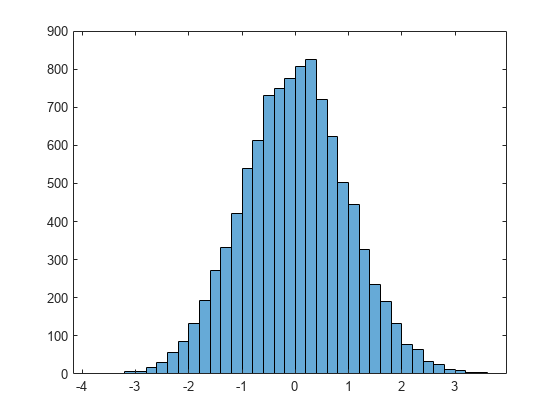
h = Histogram with properties: Data: [10000x1 double] Values: [2 2 1 6 7 17 29 57 86 133 193 271 331 421 540 613 ... ] NumBins: 37 BinEdges: [-3.8000 -3.6000 -3.4000 -3.2000 -3 -2.8000 -2.6000 ... ] BinWidth: 0.2000 BinLimits: [-3.8000 3.6000] Normalization: 'count' FaceColor: 'auto' EdgeColor: [0 0 0] Show all properties
When you specify an output argument to thehistogramfunction, it returns a histogram object. You can use this object to inspect the properties of the histogram, such as the number of bins or the width of the bins.
Find the number of histogram bins.
nbins = h.NumBins
nbins = 37
Specify Number of Histogram Bins
Plot a histogram of 1,000 random numbers sorted into 25 equally spaced bins.
x = randn(1000,1); nbins = 25; h = histogram(x,nbins)
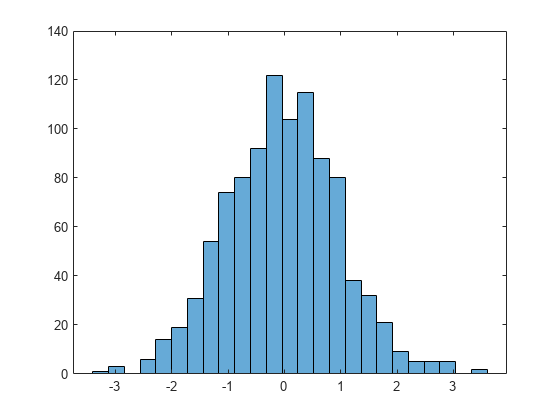
h = Histogram with properties: Data: [1000x1 double] Values: [1 3 0 6 14 19 31 54 74 80 92 122 104 115 88 80 38 32 ... ] NumBins: 25 BinEdges: [-3.4000 -3.1200 -2.8400 -2.5600 -2.2800 -2 -1.7200 ... ] BinWidth: 0.2800 BinLimits: [-3.4000 3.6000] Normalization: 'count' FaceColor: 'auto' EdgeColor: [0 0 0] Show all properties
Find the bin counts.
counts = h.Values
counts =1×251 3 0 6 14 19 31 54 74 80 92 122 104 115 88 80 38 32 21 9 5 5 5 0 2
Change Number of Histogram Bins
Generate 1,000 random numbers and create a histogram.
X = randn(1000,1); h = histogram(X)

h = Histogram with properties: Data: [1000x1 double] Values: [3 1 2 15 17 27 53 79 85 101 127 110 124 95 67 32 27 ... ] NumBins: 23 BinEdges: [-3.3000 -3.0000 -2.7000 -2.4000 -2.1000 -1.8000 ... ] BinWidth: 0.3000 BinLimits: [-3.3000 3.6000] Normalization: 'count' FaceColor: 'auto' EdgeColor: [0 0 0] Show all properties
Use themorebinsfunction to coarsely adjust the number of bins.
Nbins = morebins(h); Nbins = morebins(h)
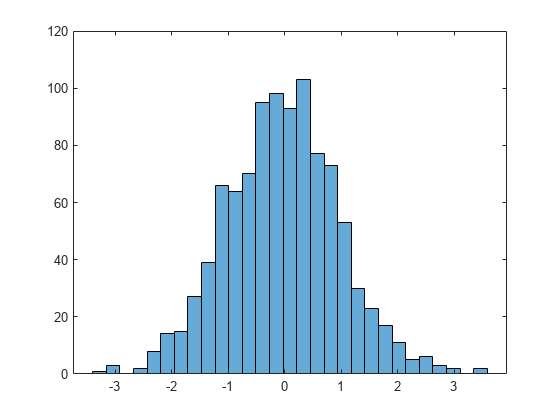
Nbins = 29
Adjust the bins at a fine grain level by explicitly setting the number of bins.
h.NumBins = 31;
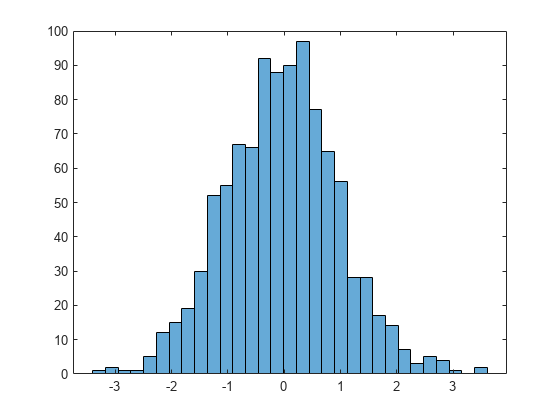
Specify Bin Edges of Histogram
Generate 1,000 random numbers and create a histogram. Specify the bin edges as a vector with wide bins on the edges of the histogram to capture the outliers that do not satisfy . The first vector element is the left edge of the first bin, and the last vector element is the right edge of the last bin.
x = randn(1000,1); edges = [-10 -2:0.25:2 10]; h = histogram(x,edges);
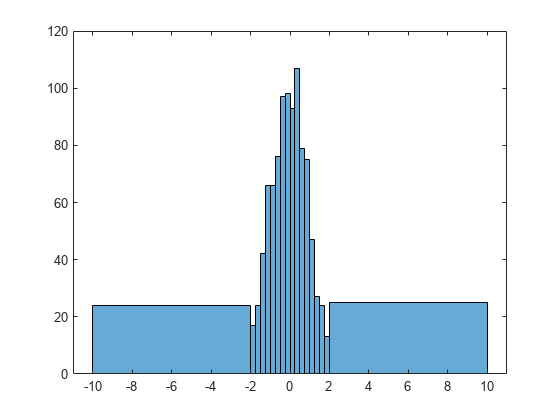
Specify theNormalizationproperty as'countdensity'to flatten out the bins containing the outliers. Now, theareaof each bin (rather than the height) represents the frequency of observations in that interval.
h.Normalization ='countdensity';
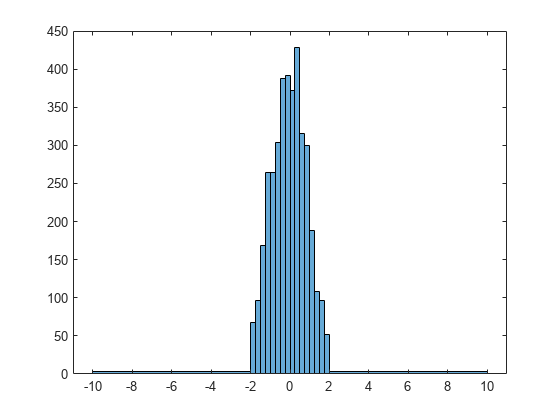
Plot Categorical Histogram
Create a categorical vector that represents votes. The categories in the vector are'yes','no', or'undecided'.
A = [0 0 1 1 1 0 0 0 0 NaN NaN 1 0 0 0 1 0 1 0 1 0 0 0 1 1 1 1]; C = categorical(A,[1 0 NaN],{'yes','no','undecided'})
C =1x27 categoricalColumns 1 through 9 no no yes yes yes no no no no Columns 10 through 16 undecided undecided yes no no no yes Columns 17 through 25 no yes no yes no no no yes yes Columns 26 through 27 yes yes
Plot a categorical histogram of the votes, using a relative bar width of0.5.
h = histogram(C,'BarWidth',0.5)
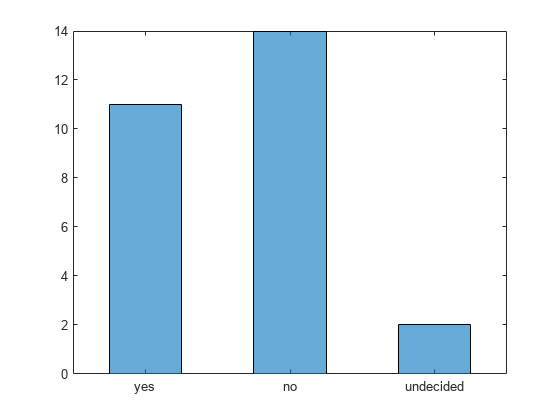
h = Histogram with properties: Data: [no no yes yes yes no no ... ] Values: [11 14 2] NumDisplayBins: 3 Categories: {'yes' 'no' 'undecided'} DisplayOrder: 'data' Normalization: 'count' DisplayStyle: 'bar' FaceColor: 'auto' EdgeColor: [0 0 0] Show all properties
Histogram with Specified Normalization
Generate 1,000 random numbers and create a histogram using the'probability'normalization.
x = randn(1000,1); h = histogram(x,'Normalization','probability')
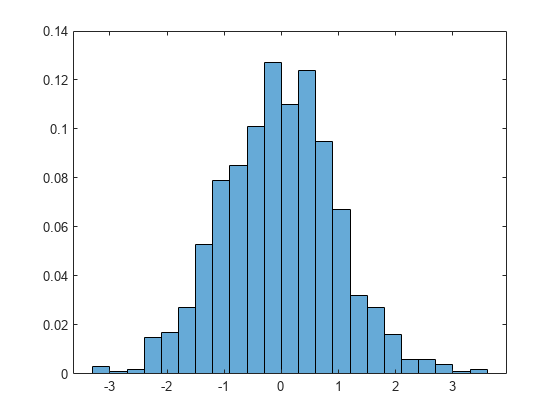
h = Histogram with properties: Data: [1000x1 double] Values: [0.0030 1.0000e-03 0.0020 0.0150 0.0170 0.0270 0.0530 ... ] NumBins: 23 BinEdges: [-3.3000 -3.0000 -2.7000 -2.4000 -2.1000 -1.8000 ... ] BinWidth: 0.3000 BinLimits: [-3.3000 3.6000] Normalization: 'probability' FaceColor: 'auto' EdgeColor: [0 0 0] Show all properties
Compute the sum of the bar heights. With this normalization, the height of each bar is equal to the probability of selecting an observation within that bin interval, and the height of all of the bars sums to 1.
S = sum(h.Values)
S = 1
Plot Multiple Histograms
Generate two vectors of random numbers and plot a histogram for each vector in the same figure.
x = randn(2000,1); y = 1 + randn(5000,1); h1 = histogram(x); holdonh2 = histogram(y);

Since the sample size and bin width of the histograms are different, it is difficult to compare them. Normalize the histograms so that all of the bar heights add to 1, and use a uniform bin width.
h1.Normalization ='probability'; h1.BinWidth = 0.25; h2.Normalization ='probability'; h2.BinWidth = 0.25;
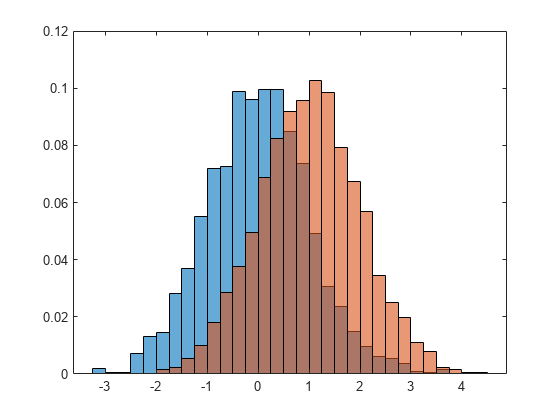
Adjust Histogram Properties
Generate 1,000 random numbers and create a histogram. Return the histogram object to adjust the properties of the histogram without recreating the entire plot.
x = randn(1000,1); h = histogram(x)
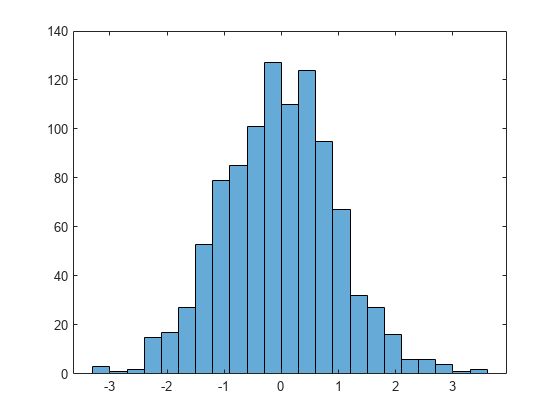
h = Histogram with properties: Data: [1000x1 double] Values: [3 1 2 15 17 27 53 79 85 101 127 110 124 95 67 32 27 ... ] NumBins: 23 BinEdges: [-3.3000 -3.0000 -2.7000 -2.4000 -2.1000 -1.8000 ... ] BinWidth: 0.3000 BinLimits: [-3.3000 3.6000] Normalization: 'count' FaceColor: 'auto' EdgeColor: [0 0 0] Show all properties
Specify exactly how many bins to use.
h.NumBins = 15;
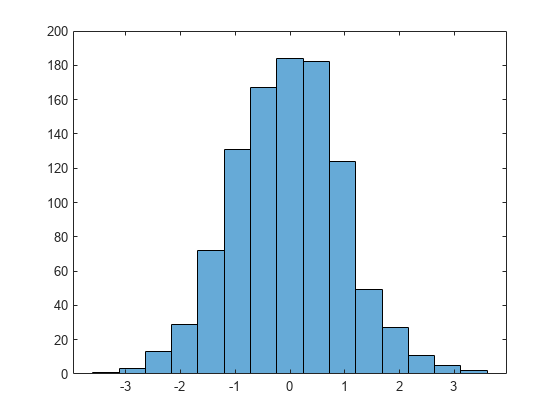
Specify the edges of the bins with a vector. The first value in the vector is the left edge of the first bin. The last value is the right edge of the last bin.
h.BinEdges = [-3:3];
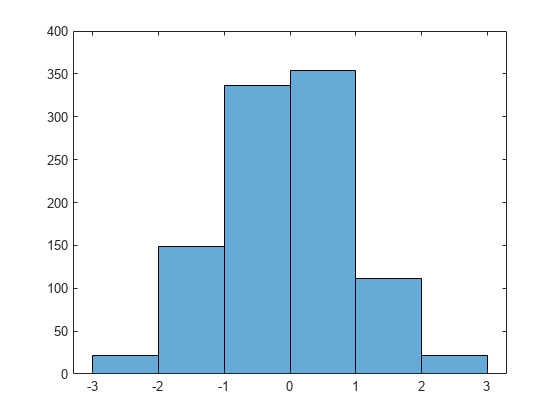
Change the color of the histogram bars.
h.FaceColor = [0 0.5 0.5]; h.EdgeColor ='r';

Determine Underlying Probability Distribution
Generate 5,000 normally distributed random numbers with a mean of 5 and a standard deviation of 2. Plot a histogram withNormalizationset to'pdf'to produce an estimation of the probability density function.
x = 2*randn(5000,1) + 5; histogram(x,'Normalization','pdf')
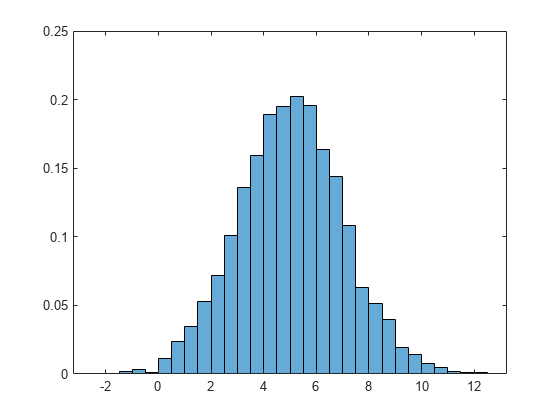
In this example, the underlying distribution for the normally distributed data is known. You can, however, use the'pdf'histogram plot to determine the underlying probability distribution of the data by comparing it against a known probability density function.
The probability density function for a normal distribution with mean , standard deviation , and variance is
Overlay a plot of the probability density function for a normal distribution with a mean of 5 and a standard deviation of 2.
holdony = -5:0.1:15; mu = 5; sigma = 2; f = exp(-(y-mu).^2./(2*sigma^2))./(sigma*sqrt(2*pi)); plot(y,f,'LineWidth',1.5)
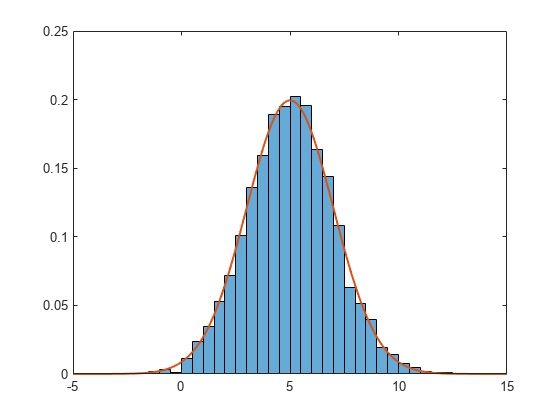
Saving and Loading Histogram Objects
Use thesavefigfunction to save ahistogramfigure.
histogram(randn(10)); savefig('histogram.fig'); closegcf
Useopenfigto load the histogram figure back into MATLAB.openfigalso returns a handle to the figure,h.
h = openfig('histogram.fig');

Use thefindobjfunction to locate the correct object handle from the figure handle. This allows you to continue manipulating the original histogram object used to generate the figure.
y = findobj(h,'type','histogram')
y = Histogram with properties: Data: [10x10 double] Values: [2 17 28 32 16 3 2] NumBins: 7 BinEdges: [-3 -2 -1 0 1 2 3 4] BinWidth: 1 BinLimits: [-3 4] Normalization: 'count' FaceColor: 'auto' EdgeColor: [0 0 0] Show all properties
Tips
Histogram plots created using
histogramhave a context menu in plot edit mode that enables interactive manipulations in the figure window. For example, you can use the context menu to interactively change the number of bins, align multiple histograms, or change the display order.When you add data tips to a histogram plot, they display the bin edges and bin count.
Extended Capabilities
Tall Arrays
Calculate with arrays that have more rows than fit in memory.
This function supports tall arrays with the limitations:
Some input options are not supported. The allowed options are:
'BinWidth''BinLimits''Normalization''DisplayStyle''BinMethod'— The'auto'and'scott'bin methods are the same. The'fd'bin method is not supported.'EdgeAlpha''EdgeColor''FaceAlpha''FaceColor''LineStyle''LineWidth''Orientation'
Additionally, there is a cap on the maximum number of bars. The default maximum is 100.
The
morebinsandfewerbinsmethods are not supported.Editing properties of the histogram object that require recomputing the bins is not supported.
For more information, seeTall Arrays for Out-of-Memory Data.
GPU数组
Accelerate code by running on a graphics processing unit (GPU) using Parallel Computing Toolbox™.
Usage notes and limitations:
This function accepts GPU arrays, but does not run on a GPU.
For more information, seeRun MATLAB Functions on a GPU(Parallel Computing Toolbox).
Distributed Arrays
Partition large arrays across the combined memory of your cluster using Parallel Computing Toolbox™.
Usage notes and limitations:
This function operates on distributed arrays, but executes in the client MATLAB.
For more information, seeRun MATLAB Functions with Distributed Arrays(Parallel Computing Toolbox).
Version History
Open Example
You have a modified version of this example. Do you want to open this example with your edits?
MATLAB Command
You clicked a link that corresponds to this MATLAB command:
Run the command by entering it in the MATLAB Command Window. Web browsers do not support MATLAB commands.

Select a Web Site
Choose a web site to get translated content where available and see local events and offers. Based on your location, we recommend that you select:.
You can also select a web site from the following list:
How to Get Best Site Performance
Select the China site (in Chinese or English) for best site performance. Other MathWorks country sites are not optimized for visits from your location.
Americas
- América Latina(Español)
- Canada(English)
- United States(English)
Europe
- Belgium(English)
- Denmark(English)
- Deutschland(Deutsch)
- España(Español)
- Finland(English)
- France(Français)
- Ireland(English)
- Italia(Italiano)
- Luxembourg(English)
- Netherlands(English)
- Norway(English)
- Österreich(Deutsch)
- Portugal(English)
- Sweden(English)
- Switzerland
- United Kingdom(English)